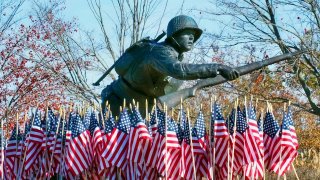D-Day 80th Anniversary: The Invasion That Changed the Course of World War II
The legendary amphibious landing of World War II was the result of multiple years of intense planning and argument by the American and British militaries. It changed the course of history forever.
As General Lord Ismay explained in his memoirs, airborne troops needed darkness “to conceal their approach, but sufficient moonlight to enable them to identify their dropping zones”—in other words, a late-rising moon. But there needed to be enough time after dawn to allow “the sea-borne assault to identify their beaches, and the warships to identify the target for bombardment” while not being long enough “to enable the enemy to recover from his surprise before the infantry assault started.” Furthermore, the tide had to be low enough “for the underwater obstacles to be exposed, but not so low as to involve the attacking troops in an unduly long advance across the beaches.” The Defence Committee assumed that the opening window for such particular weather in June would be between June 5 and 7.
At 4:00 AM on June 5, Eisenhower’s command team met to discuss final preparations. The staff meteorologist, Captain Stagg, informed them that the weather was likely to improve the next day. Eisenhower then responded, “OK. We’ll go.”
Thus, all was set into motion. The following day, the largest land, sea, and air invasion in history commenced.
About the Author
Andreas Koureas is an aspiring economist and historian. He is currently studying Political Economy at King’s College London. His main research focus is on Winston Churchill and the British Empire. He has written for publications such as The Spectator and academic institutions like Hillsdale College. He is writing a paper on the 1943 Bengal Famine for a peer-reviewed journal later this year. Follow him on X: @AndreasKoureas_.
Image: Shutterstock.com.


